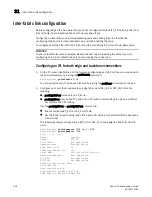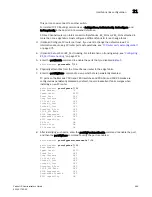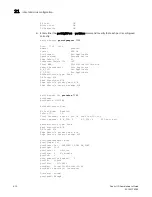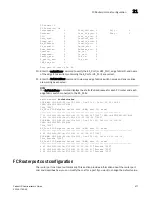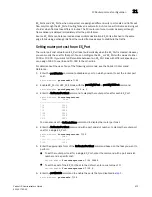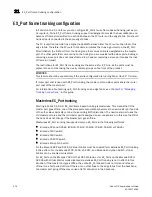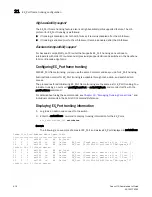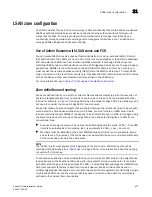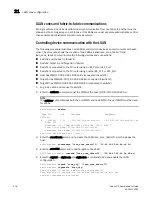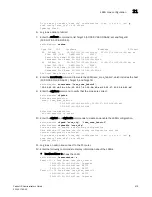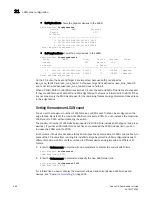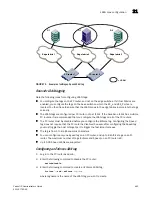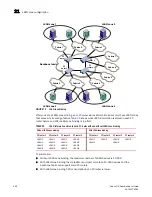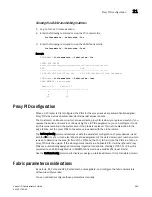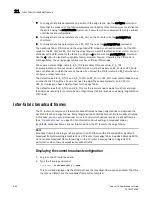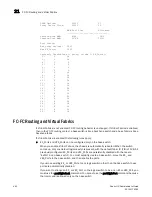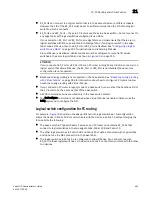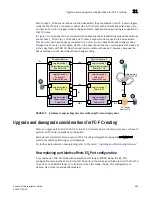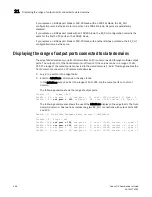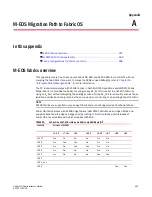
482
Fabric OS Administrator’s Guide
53-1001763-02
LSAN zone configuration
21
Normally the FC router automatically accepts all zones with names that start with “lsan_”. You can
specify an Enforce tag to indicate that a particular FC router should only accept zones that start
with the prefix “lsan_
tag
”. For example, if you specify an Enforce tag of “abc”, the FC router accepts
only those LSAN zones that start with “lsan_abc” and does not import or export any other LSAN
zones.
The Enforce tag can be up to 8 characters long and can contain only letters and numbers. The
Enforce tag is case-insensitive; for example, the tag “abc” is equivalent to “ABC” and “Abc”.
If you specify “abc”, “xyz”, and “fab1” as Enforce tags, then the FC router accepts only those LSAN
zones with names that start with any of the following:
lsan_abc
lsan_xyz
lsan_fab1
In this example, the following LSAN zones would all be accepted:
lsan_abc
Lsan_xyz123456
LSAN_FAB1_abc
You can specify up to eight Enforce tags on an FC router.
Speed tag
During target discovery, the FC router process of presenting proxy devices and setting up paths to
the proxy devices might cause some sensitive hosts to time out or fail. The Speed tag allows you to
speed up the discovery process by importing the devices into the remote edge fabrics when the
devices come online, regardless of the state of the host. This helps sensitive hosts to quickly
discover the devices without timing out.
You set the Speed tag on the FC router, and then configure the LSANs in the target edge fabrics
with the tag.
For example, in
Figure 74
on page 483 assume that the host, H1, needs fast access to target
devices D1 and D2. You could set up the Speed tag as follows:
1. In FC router 1 and FC router 2, configure the Speed tag as “super”.
2. In edge fabric 2, configure two LSANs:
lsan_f2_f1 (H1, D1)
lsan_f2_f3 (H1, D2)
The LSAN in the host fabric does not need the tag.
3. In edge fabric 1, configure the following LSAN:
lsan_super_f1_f2 (H1, D1)
4. In edge fabric 3, configure the following LSAN:
lsan_super_f3_f2 (H1, D2)
5. Toggle either the host or target to trigger the fast import process.
The “super” tag is needed only in the LSANs of the target fabrics.
The target proxies D1 and D2 are always present in the host fabric (edge fabric 2), even if the host
is brought down. A target proxy is removed from the host fabric when the target device is offline.
Summary of Contents for 53-1001763-02
Page 1: ...53 1001763 02 13 September 2010 Fabric OS Administrator s Guide Supporting Fabric OS v6 4 0 ...
Page 4: ...iv Fabric OS Administrator s Guide 53 1001763 02 ...
Page 24: ...xxiv Fabric OS Administrator s Guide 53 1001763 02 ...
Page 28: ...xxviii Fabric OS Administrator s Guide 53 1001763 02 ...
Page 32: ...xxxii Fabric OS Administrator s Guide 53 1001763 02 ...
Page 40: ...xl Fabric OS Administrator s Guide 53 1001763 02 ...
Page 42: ...2 Fabric OS Administrator s Guide 53 1001763 02 ...
Page 54: ...14 Fabric OS Administrator s Guide 53 1001763 02 High availability of daemon processes 1 ...
Page 74: ...34 Fabric OS Administrator s Guide 53 1001763 02 Basic connections 2 ...
Page 102: ...62 Fabric OS Administrator s Guide 53 1001763 02 Audit log configuration 3 ...
Page 214: ...174 Fabric OS Administrator s Guide 53 1001763 02 Management interface security 7 ...
Page 228: ...188 Fabric OS Administrator s Guide 53 1001763 02 Brocade configuration form 8 ...
Page 276: ...236 Fabric OS Administrator s Guide 53 1001763 02 Creating a logical fabric using XISLs 10 ...
Page 404: ...364 Fabric OS Administrator s Guide 53 1001763 02 ...
Page 440: ...400 Fabric OS Administrator s Guide 53 1001763 02 Performance data collection 17 ...
Page 480: ...440 Fabric OS Administrator s Guide 53 1001763 02 F_Port masterless trunking 19 ...
Page 494: ...454 Fabric OS Administrator s Guide 53 1001763 02 Buffer credit recovery 20 ...
Page 574: ...534 Fabric OS Administrator s Guide 53 1001763 02 Hexadecimal overview E ...

